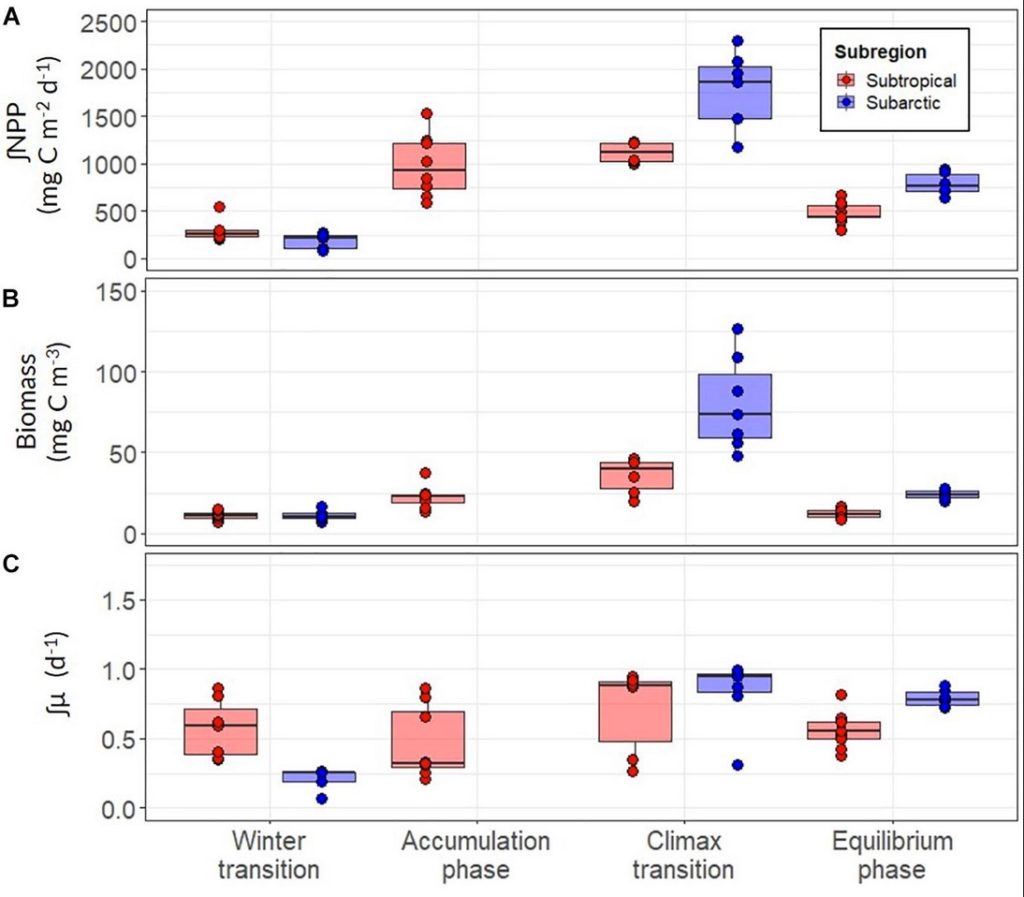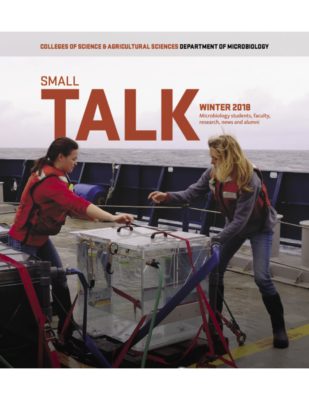

Phytoplankton Physiological Ecology

Eric’s work on VOCs produced by a diatom. Many of these VOCs are consumed by SAR11, causing the diatom to work 20% harder to keep up with the bacterial demand! Eric compared VOC production by T. pseudonana in monoculture and in co-culture with HTCC1062. He used PTR-ToF/MS and a clever experiment using a hydrocarbon trap to show the impact of VOC consumption on carbon fixation rates. Published in Environmental Microbiology.
The parasitic arsenic cycle!!! This is such a cool discovery about how SAR11 exploits the detoxification efforts of phytoplankton!
https://mbio.asm.org/content/10/2/e00246-19
Here’s our Department’s new newsletter! Cleo and I made the cover, and there’s a nice little blurb on the lab’s work inside.

New paper featuring Lindsay’s work showing Anabaena can be sources of deadly amounts of microcystin. This is a surprising finding because previously Microcystis was thought to be the major microcystin producer. In addition, Lindsay found a large insert in one of the microcystin synthesis genes. Considering that the toxin is produced non-ribosomally, questions remain….
Kelsey’s paper is out!
McBeain and Halsey (2018). Altering phytoplankton growt rates changes their value as food for microzooplankton grazers. Aquatic Microbial Ecology 82:19-29. doi.org/10.3354.ame01880
This was an interesting study that required some pretty amazing skills – well done, Kelsey!
Our newest lab paper was published today. This manuscript describes two important discoveries in diatom lifecycles.
PLoS ONE 12(7): e0181098. https://doi.org/10.1371/journal.pone.0181098
1.) Thalassiosira pseudonana IS a sexual diatom species
2.) Ammonium induces sex in T. pseudonana and at least two other centric diatoms.
To prove these discoveries, Eric Moore with help from Briana Bullington carried out a number of carefully controlled culturing experiments, imaged all of the cell morphologies in the lifecycle, and identified >1,200 genes that were differentially expressed under conditions of ammonium induced cell differentiation. Some of these genes are involved in meiosis, flagellar synthesis, and sex differentiation.
Thanks to all of our co-authors, Alex Weisberg, Jeff Chang, and Yuan Jiang for their help with gene expression analysis and statistical testing.
Nobody had ever seen the model centric diatom, Thalassiosira pseudonana, undergo sexual reproduction. Grad student, Eric Moore, documented the sexual stages and showed upregulation of genes involved in meiosis and flagellar synthesis. Moreover, he figured out what triggers these diatoms and other centric diatoms to shift into the sexual cycle resulting in cell enlargement. Read about it here on BioRxiv.
doi: https://doi.org/10.1101/144667

 Our most recent paper on VOC cycling in the surface ocean was just published in Limnology and Oceanography. Phytoplankton produce different profiles of VOCs depending on species and some bacterioplankton, including the ubiquitous and abundant SAR11 bacteria consume these compounds. We designed new incubation chambers and attached these chambers to a PTR-MS to make real time measurements of VOC production and consumption . This work was a collaborative effort with atmospheric physicists at NOAA. Halsey et al. 2017 doi: 10.1002/lno.10596
Our most recent paper on VOC cycling in the surface ocean was just published in Limnology and Oceanography. Phytoplankton produce different profiles of VOCs depending on species and some bacterioplankton, including the ubiquitous and abundant SAR11 bacteria consume these compounds. We designed new incubation chambers and attached these chambers to a PTR-MS to make real time measurements of VOC production and consumption . This work was a collaborative effort with atmospheric physicists at NOAA. Halsey et al. 2017 doi: 10.1002/lno.10596
Our newest paper on photosynthetic energy use was accepted yesterday in Photosynthesis Research. Former graduate student Nerissa Fisher (MS 2015) discovered that under very low light availability, diatoms shift their metabolism in favor of very short ATP generating pathways that circumvent carbon intermediates. These results suggest that this type of pathway gating facilitates the remarkably high efficiencies with which diatoms convert light energy into biomass, especially in low light (Fisher and Halsey, 2016). The paper can be found here:
Mechanisms that increase the growth efficiency of diatoms in low light
© 2025 Kimberly Halsey
Theme by Anders Noren — Up ↑